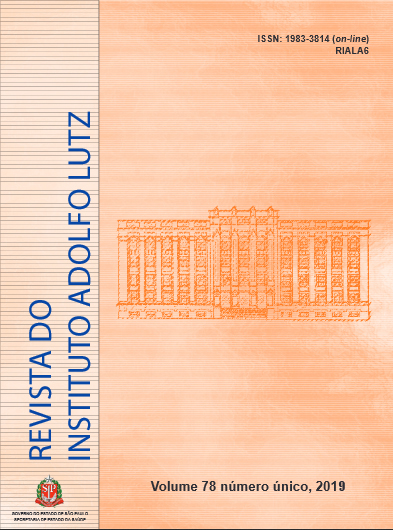Abstract
Intestinal parasitic infections are widely distributed throughout the world and children are the
most affected population. The objective of the present study was to evaluate the prevalence of
parasitic maternal and infant intestinal infection of patients attended at a public health unit in
the municipality of Lagoa Santa, Minas Gerais. The centrifugal-sedimentation in formol-ether
was the technica used for stool analysis. Positivity was observed in 41.7% for pregnant women,
37.3% for mothers and 35.7% for children. Endolimax nana (17.1%) and Giardia intestinalis
(17.1%) were the most frequently detected parasites in children under two-years old and pregnant
women (33.3%). For mothers, G. intestinalis (20.3%) was the most prevalent parasite followed
by Entamoeba coli (17%). Simultaneous infection of mother and child was detected in 7 of 25
infected children. Despite health educations actions, improvement in educational level, and
access to medical services, the frequency of endoparasite infections remains high. Literature
is scarce in relation to the present theme and it is believed that infected mothers can contribute
for parasitic infection of their kids, just as children can be a source of infection for their mothers.
References
Gomes MA. High prevalence of enteroparasitosis in
urban slums of Belo Horizonte-Brazil. Presence of
enteroparasites as a risk factor in the family group.
Pathog Glob Health. 2013;107(6):320-4. https://
dx.doi.org/10.1179/2047773213Y.0000000107
2. Bini S, Alves L, Simionatto M, Miné JC.
Enteroparasitoses e situação nutricional de gestantes
atendidas em unidades básicas de saúde do
município de Ponta Grossa - PR. Publ UEPG Ci Biol
Saúde. 2015; 21(1):65-74. http://doi.org/10.5212/
publicatio%20uepg.v21i1.7134
3. McClure EM, Meshnick SR, Mungai P, Malhotra I,
King CL, Goldenberg RL et al. The association of
parasitic infections in pregnancy and maternal and
fetal anemia: a cohort study in Coastal Kenya. PLoS
Negl Trop Dis. 2014;8(2):e2724. https://dx.doi.
org/10.1371/journal.pntd.0002724
4. Freitas DA, Paiva ALR, Carvalho Filho JAA, Cabral
JJS, Rocha FJS. Occurrence of Cryptosporidium spp.,
Giardia spp. and other pathogenic intestinal parasites
in the Beberibe River in the State of Pernambuco,
Brazil. Rev Soc Bras Med Trop. 2015;48(2):220-3.
http://dx.doi.org/10.1590/0037-8682-0174-2014
5. Soares CVD, Albino SL, Silva RC, Duarte ABS,
Queiroga CD, Medeiros JS. Prevalência de
enteroparasitoses em crianças de uma creche pública
no município de Campina Grande. J Biol Pharm
Agricult Manag. 2016;12(4):28-38. Disponível em:
http://revista.uepb.edu.br/index.php/biofarm/
article/view/3262
6. Andrade AO, de Sá ARN, Bezagio RC. Prevalência
de parasitoses intestinais em crianças de um
Centro Municipal de Educação Infantil em Campo
Mourão, PR/Brasil. Uningá Rev. 2017;29(3):36-41.
Disponível em: http://revista.uninga.br/index.php/
uningareviews/article/view/1971
7. Cañete R, Díaz MM, García RA , Martinez PML ,
Ponce FM. Intestinal parasites in children from a
Day Care Centre in Matanzas City, Cuba. PLoS ONE.
2012; 7(12):e51394. https://dx.doi.org/10.1371/
journal.pone.0051394
8. Hooshyar H, Rostamkhani P, Arbabi M, Delavari
M. Giardia lamblia infection: review of current
diagnostic strategies. Gastroenterol Hepatol
Bed Bench. 2019; 12(1):3-12. Disponível em:
https://www.ncbi.nlm.nih.gov/pmc/articles/
PMC6441489/pdf/GHFBB-12-003.pdf
9. Coêlho MDG, Ramos LL, Pereira RB, Rocha LO,
Lino FPS, Coêlho FAS. Avaliação do consumo
de Lactobacillus casei Shirota para o controle
de giardíase em ciranças. Rev Patol Trop.
2016;45(2):169-78. https://dx.doi.org/10.5216/rpt.v45i2.41772
10. Oliveira BSB, Oliveira RKL, Bezerra JC, Melo FMS,
Monteiro FPM, Joventino ES. Social conditions
and maternal conducts in the prevention and
management of infantile diarrhea. Cogitare Enferm.
2017;22(4):e50294. http://dx.doi.org/10.5380/
ce.v22i4.50294
11. Mahmud MA, Spigt M, Bezabih AM, Pavon IL,
Dinant GJ, Velasco RB. Risk factors for intestinal
parasitosis, anaemia, and malnutrition among
school children in Ethiopia. Pathog Glob Health.
2013;107(2):58-65. http://dx.doi.org/10.1179/20477
73213Y.0000000074
12. Hicks JH, Kremer M, Miguel E. The case
for mass treatment of intestinal helminths
in endemic areas. PLoS Negl Trop Dis.
2 0 1 5 . 9 ( 1 0 ) : e 0 0 0 4 2 1 4 . h t t p s : / / d x . d o i .
org/10.1371/journal.pntd.0004214
13. Ndibazza J, Muhangi L, Akishule D, Kiggundu M,
Ameke C, Oweka J et al. Effects of deworming during
pregnancy on maternal and perinatal outcomes in
Entebbe, Uganda: a randomized controlled trial.
Clin Infect Dis. 2010;50(4):531–40. https://dx.doi.
org/10.1086/649924
14. D`Alauro F, Lee RV, Pao-In K, Khairallah M.
Intestinal parasites and pregnancy. Obstet
Gynecol.1985;66(5):639-43. [resumo]. Disponível
em: https://pubmed.ncbi.nlm.nih.gov/4058821/
15. Perloroth NH, Castelo Branco WC. Current
knowledge of environmental exposure in children
during the sensitive developmental periods. J Pediatr.
2017;93(1):17-27. https://dx.doi.org/10.1016/j.
jped.2016.07.002

This work is licensed under a Creative Commons Attribution 4.0 International License.
Copyright (c) 2019 Instituto Adolfo Lutz Journal
